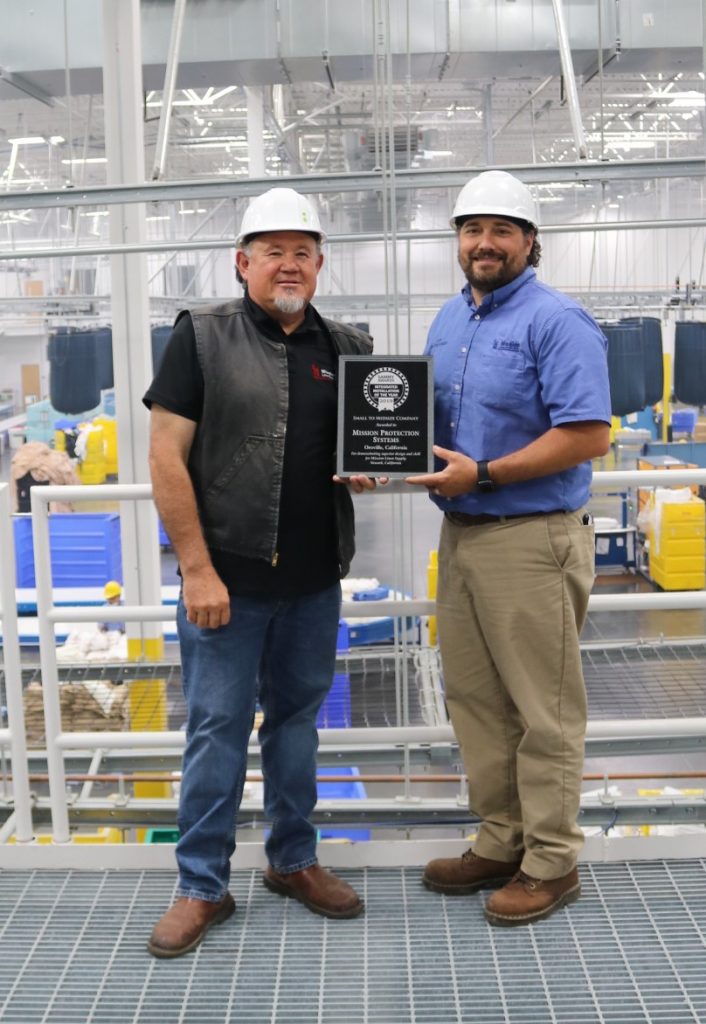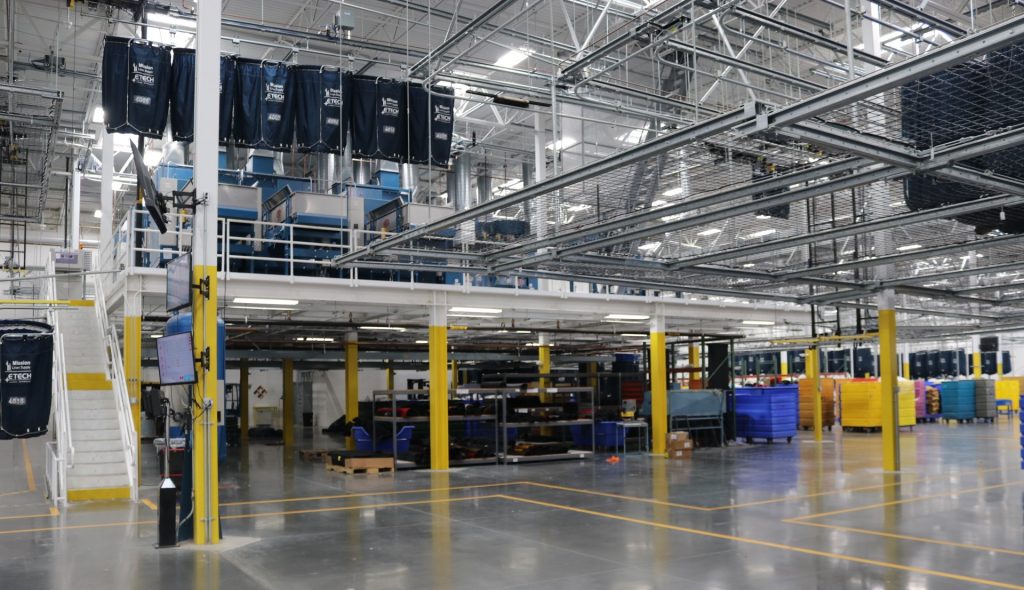Founded in 1930, Santa Barbara, Calif.-based Mission Linen Supply has expanded beyond the linen rental and uniform business to include the service and sale of apparel, mats and janitorial products. Today the company operates 43 facilities in California, Arizona, Texas, Oregon and New Mexico, and has a fleet of more than 800 vehicles.
Many hundreds of items arrive at Mission Linen facilities each day that are considered high-hazard materials because they contain grease or oils that can spontaneously combust. Therefore it is vital to monitor the temperature of the fabrics to prevent fires from breaking out.
“Mission Linen traditionally checks high-hazard materials using a manual thermal gun at two stages in our process: before the material is washed and after it has been dried,” explains the company’s operations manager, Aaron Milroy.
The large majority of Mission Linen industrial laundry plants can easily use a manual thermal gun in this fashion since the materials are staged at the ground level. However, the company’s new state-of-the-art facility in Newark, Calif., features an updated layout. Here, items that are being prepared for laundering are suspended overnight from the ceiling in large laundry sacks or slings.
“All of our material at the Newark location is staged 20 feet up in the air, which makes it difficult to check manually,” Milroy says. Enter Mission Protection Systems, an Oroville, Calif.-based installing security contractor founded by security industry veteran Larry Tracy, a 2008 SSI Hall of Fame inductee.
Mission Protection initially learned about the security and life-safety needs at the 100,000-square-foot Newark facility after a Mission Linen corporate engineer requested the company tour the site and bid on the project.
During the first job walk the end customer asked for an intrusion alarm to cover the perimeter, and a video surveillance system to monitor areas they felt would have a potential for worker’s compensation cases and to troubleshoot issues on the production floor.
“During this job walk, we asked the customer what their biggest liability was in a facility of this kind,” explains Mission Protection Systems Director of Sales & Marketing Susan Smith.
“[Milroy] pointed to the large slings and explained how they have a major issue with spontaneous combustion at certain stages of the laundry process. We offered them the solution of integrating thermal cameras into the CCTV system, so that when the sacks reach a certain set temperature we would notify them through the intrusion alarm system.”
That intial job walk in late September 2017 resulted in Mission Protection’s first ever project integrating Hikvision’s advanced heat detection thermal cameras with a Honeywell intrusion system. Read on to learn how this unique project surpassed Integrated Installation of the Year criteria for innovation, systems design, uniqueness of application, ease of operation, end-user satisfaction and more.

Mission Linen Supply colleagues Izzy Castro, VP of engineering (left), and Aaron Milroy, operations manager, hoist the Integrated Installation of the Year Award plaque at the Newark, Calif., facility.
Mission Not Impossible
Mission Protection would ultimately draft three proposals over the course of two weeks to fulfill the end customer’s goals for its new video surveillance, perimeter intrusion detection and integrated thermal security solution.
“The initial 4-megapixel [MP] camera count went from 49 to 96. The contract was signed and installation began in late October 2017. Taking into account two major holidays, it took around two months to complete the installation. We fully wrapped up the project in January 2018,” says Smith, who was in charge of project management for the job.
The intrustion equipment comprised a Honeywell Vista 128 control panel, two glass-break detectors, four motion detectors, GSM Radio backup, 16 surface-mount man door contacts, 24 overhead door contacts, four indoor sirens, two roof hatch contacts, three Honeywell 4208 multiplexers and three Honeywell alpha keypads.
More than 80 Hikvision 4MP fixed dome cameras are placed throughout the plant and office. Cameras watch the laundry as it is offloaded from the trucks on the loading docks; as it moves into the soil sort station; through the washing and drying process; and finally to the finish area where it is pressed, folded and packaged for delivery.
“There is not one area of the plant that cannot be seen from one of the 4MP cameras. Around the perimeter, 13 outdoor cameras were used to watch two driveways, loading docks, all exterior doors and parking lots,” Smith says.
The project’s roster of video surveillance gear included back boxes for the cameras; six 6TB surveillance-grade hard drives; 20 IP switches; a dozen hub boxes; a 128-channel NVR; and 23-inch monitors located at the NVR, Milroy’s office and the plant engineer’s office.
Mission Linen Supply’s contractor used their own electrician to start the electrical work needed at the hub boxes. Mission Protection had them pull power to the hubs and then the company used its own in-house electrician to finish the installation of the electrical outlets inside the hubs and at the power supplies.
Smith was onsite each day and in constant contact with the end customer, as well as the electricians, conducting daily progress reports. The reports included estimating the percentage of what had been completed and what was still uncompleted, updating plans with any changes or additions, and delivering copies of updated plans, scope of work and progress reports to Mission Protection’s installation crew.
Monitored Thermal Cameras
The project called for the installation of seven Hikvision DS-2TD2136-15 thermal network bullet cameras, which were placed strategically to monitor the interior and perimeter of the laundry sacks in areas with the highest risk of overheating. Equipped with a temperature alarm and an advanced fire detection algorithm, the cameras are well-suited for temperature and fire monitoring.
Because this was Mission Protection’s first project using heat detection thermal cameras, the company relied heavily on Hikvision engineers and its thermal camera business development manager, Tony DeStefano, for advice.
Along with providing several pictures and drawings to DeStefano, he flew out to the plant from New Jersey to advise on camera layout to ensure the most comprehensive detection of temperature increases across the slings.
The biggest challenge Mission Protection faced was figuring out proper placement of the thermals in areas of high fire potential, especially where the laundry sacks are densely packed in from the hanging rails.
“If a fire were to break out, it can have a big impact on their operations, shutting down a facility for up to a month, with the potential loss of customers,” Destefano says.
The integrator was also challenged with determining the proper temperature settings at each location of the thermal camera. This took some trial and error over a few days once the plant was fully operational. “We initially started out as low as 120° and quickly had false alarms,” Smith explains. “The temperature was finally dialed in at 150° and 160°, and the customer has had not experienced any false alarms at this temperature setting.”
All cameras are mounted on I-beams, metal poles, concrete walls and two hanging ceiling mounts made from 2-inch conduit. Three thermal cameras are installed in the soil sorter station where the dirty laundry sacks are loaded off the trucks.
One thermal camera is installed overlooking the mezzanine where three dryers are located. Specifically, this camera is viewing the laundry coming off of three dryer conveyer belts before it drops into one of three laundry sacks at the “dry transfer” station. Below the mezzanine and dryers, the “dry transfers drop” has three platforms that hold the sacks of laundry that come off the dryers above.
Performing thermal checks manually is an arduous task at the Newark location. “The thermal gun is able to read the temperature along the perimeter of the sling, but not for the material in the center,” Milroy says. “Another variable in our procedure is the human factor — were all bags checked and recorded correctly?”
The cameras provide thermal monitoring protection even when the plant is closed. The Newark facility opens early in the morning and closes in the evening. The cameras perform automated thermal checks with temperature monitoring around the clock.
“Our new Hikvision thermal camera setup helps ease these issues and provides more safety checks to our procedures. The cameras allow us to gather temperature readings throughout the whole sling of material and not just the perimeter,” Milroy explains. “We get readings on every sling that goes through the process at five different stages instead of two.”
As temperatures start to rise, the camera detects the increase and triggers a relay at the intrusion alarm panel. This transmits a supervisory signal to an off-site central monitoring station where personnel then calls Mission Linen Supply to notify them of the rise in temperature.
At this stage, the customer can request that the monitoring station dispatch the fire department, as well as view the cameras remotely from their phones or computers. The alarm system is one of the best parts of their newly implemented cameras, Milroy says.
“If the temperature reaches the high heat temperature that we have designated as the alert point, we will receive an email and a call from dispatch. The alarm tells us what area has a rise in temperature and we can check the cameras using our mobile phones and Hikvision’s iVMS-4200 app to pinpoint which sling has caused the alarm. We can then address it accordingly or have dispatch send out the fire department, if needed,” Milroy says.

Items prepared for laundering are suspended from the ceiling in large sacks or slings. Sometimes soiled with oil, grease and other combustibles, the slings are monitored for excessive heat build up.
Super Satisfied Customer
The customer has bi-annual inspections of the video system and thermal cameras. During these inspections, the thermal cameras are tested using a propane torch. This also provides the opportunity to clean the lint off the cameras, do any firmware updates, and make any changes the customer requests. This service expense was built into the price of the monthly monitoring fee.
The reaction from the end customer has been nothing short of outstanding for the solution, Smith says. Not only are the on-site employees who use the system regularly thrilled with the installation, she explains, but the corporate office has decided to implement the design in all of its plants.
“Before we even finished with this job, they had already had us bid the next plant we installed a CCTV system in. Since finishing this project, we have installed a similar system in two other Mission Linen plants and have given them proposals for four other plants,” she says.

The scope of work for the upcoming plants is even greater than the original installation because of the nature and size of the other locations are much larger. The return on investment (ROI) is easily justified to the customer because they have experienced plant fires from spontaneous combustion in the past. The price of investing in such a comprehensive solution was relatively low in comparison to how much a fire or a wrongful worker’s compensation claim would cost them, Smith explains.
“The thermal system has improved operational procedures with a host of other benefits to Mission Linen’s business model. Using thermal in this way was a unique application for us, and it has the potential to resolve issues for many verticals,” she says.
View the slideshow for more photos from the installation.
The post Mission Protection’s Imaginative Thermal Solution Earns SSI Installation of the Year Award appeared first on Security Sales & Integration.
